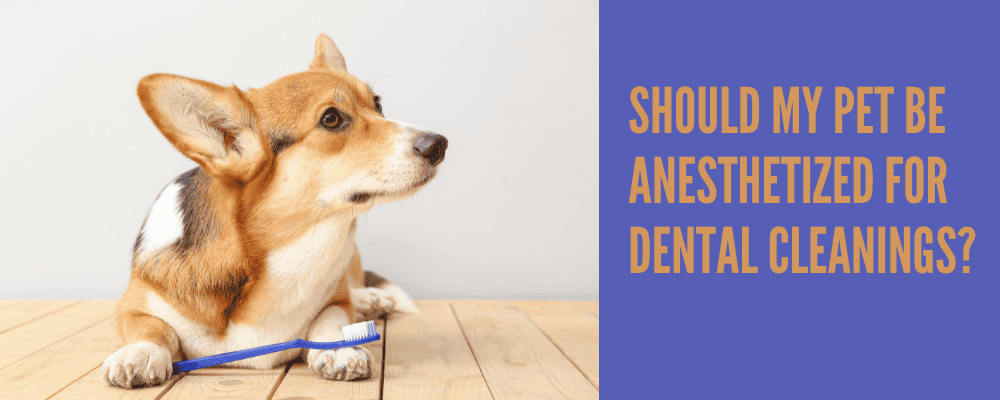Unlike humans, pets don’t understand what we are doing. So for the safety of the pet, doctor and tech, general anesthesia is required. Your pet must be anesthetized to allow thorough evaluation of his mouth, clean his teeth above and below the gumline, and treat painful dental conditions. According to the 2019 AAHA Dental Care Guidelines for Dogs and Cats, anesthesia-free dentistry is not safer and does not allow the supra- and subgingival cleaning that is able to be done in an anesthetized patient, and is therefore unacceptable. Although owners’ fear of anesthesia is the most common reason pets don’t receive medically necessary dental care, most animals do well under anesthesia and have few complications.
Why is anesthesia needed for dental procedures in pets?
Only a limited oral exam and tartar removal above the gumline is possible without anesthesia. Dental anesthesia is critical for a complete, thorough cleaning for the following reasons:
An awake animal is unlikely to allow a veterinarian to poke around his mouth with dental instruments. A complete exam that allows the veterinarian to fully determine the extent of dental disease and most oral procedures only can be performed on an anesthetized patient.
Dental x-rays should be taken with most dental exams and anesthesia is required to keep pets still for x-rays. Since 60% of a tooth is below the gumline, problems such as retained roots, root fractures, and periodontal disease only can be detected on radiographs. Without X-rays, many dental problems go undiagnosed and untreated.
A complete dental cleaning involves evaluation of pocket depth, tartar scaling above and below the gums, and polishing. Subgingival tartar removal, which is critically necessary to prevent dental disease progression, requires the insertion of dental instruments below the gumline, which can be uncomfortable.
Most patients will not hold still for tartar removal, which involves poking, prodding, bright lights, and sharp instruments. Even the limited cleaning that anesthesia-free dentistry permits is traumatic for a pet and may make him afraid to visit the veterinarian in the future.
Many pets hide painful dental problems and a proper dental cleaning can hurt sensitive teeth. Anesthesia allows your pet to rest pain-free throughout the cleaning, even when painful procedures, such as tooth extractions, are necessary.
A thorough dental exam and X-rays may reveal problems requiring immediate action such as oral surgery that can’t be treated without anesthesia. If your pet already is anesthetized, problems can be addressed immediately so he returns to you with a healthy mouth.
What precautions make anesthesia safe for my pet?
Precautions such as a thorough preanesthetic evaluation, lab work, safe medications and techniques, IV fluids and anesthetic monitoring make anesthesia safe for most pets.
Prior to anesthesia, a thorough physical exam and blood tests will be performed to screen for diseases that could cause anesthetic complications. In particular, the liver and kidneys are assessed, since they break down and eliminate anesthetic medications. Patient evaluation allows the veterinarian to customize the safest anesthetic and pain-management plan for your pet and his needs.
An intravenous catheter will be placed for fluid administration throughout the procedure and for emergency medications if complications arise.
Sedation will be administered before anesthesia to relax your pet and relieve any anxiety. About 20 minutes later, your pet will be anesthetized. He will become unconscious and completely unaware of what is happening, will feel no pain, and will have no memory of the procedure.
An endotracheal (breathing) tube will be placed in your pet for airway protection and oxygen administration, which he will receive throughout the procedure to ensure his blood stays oxygenated.
Anesthetic medications slow down the heart and lungs, so each pet is closely monitored to ensure adequate cardiovascular and respiratory function. Good dental care can be costly, but much of the costs are in items designed to make it safer, such as anesthesia, IV catheters, IV fluids, heart monitors, heat support, etc. From the moment your pet is placed under anesthesia, your AAHA-accredited veterinary team will monitor your pet’s vital signs, including:
- Heart rate and rhythm
- Heart electrical activity (via electrocardiogram)
- Blood pressure
- Respiratory rate and depth
- Blood oxygen levels (using a pulse oximeter)
- Temperature
- Mucous membrane color and capillary refill time, which indicate adequate blood flow
- Anesthetic depth
Most pets recover from anesthesia 15 to 20 minutes after the procedure. They then rest comfortably in a cage for a couple hours for continued monitoring and usually go home the same day.
With proper precautions, dental anesthesia is safe as well as necessary. All pets should receive the important dental care they need to live the healthy, pain-free life they deserve.
